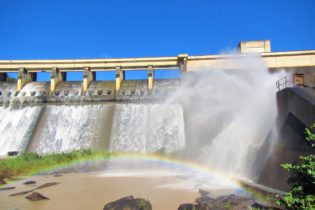The escalating frequency and intensity of natural disasters underscores a growing need for consulting engineering in disaster management planning and preparedness, explains Chalmers Pagiwa, CEO of Lubisi Consulting Engineers.
“By employing diverse mitigation strategies and technologies, consulting engineers can significantly enhance infrastructure resilience against natural disasters,” he adds. This year, the world has already seen its fair share of disasters, particularly with the wildfires in the United States, as well as flooding in the West of Africa, earthquakes in the Middle East, and multiple hurricanes and tornadoes in 2024. Across South Africa, we have seen the impact of flooding, droughts, tornadoes, and snowfall. According to the United Nations Environment Programme, a recent report found that climate change is affecting the hydrological cycle and increasing the frequency and intensity of storms, with over 90% of natural disasters being ‘weather-water-related’. Considering these facts, the expertise of consulting engineers becomes increasingly vital in mitigating the impacts of such disasters on communities and infrastructure.“These disasters always have a devastating impact on people, infrastructure and local economies and with the increasing intensity of storms or droughts, being prepared for disasters is no longer just advised, it is necessary.”For example, Pagiwa highlights the damage to infrastructure in light of flood damage. The company was recently appointed by the Department of Public Works and Cooperative Governance and Traditional Affairs to repair infrastructure in Mpumalanga, where inclement weather destroyed properties and infrastructure such as roads, bridges and other crossings in several areas. “The experience on this project reinforced the importance of not only repairing damaged infrastructure but also implementing proactive strategies that enhance resilience against future disasters.
“Consulting engineers employ rigorous risk assessment and analysis techniques that identify vulnerabilities within essential infrastructure, playing a pivotal role in developing mitigation strategies, undertaking inspections and proposing maintenance plans, aimed at reducing the risk of structural failure and damage,” notes Pagiwa.
Building on this foundation, he says that advanced modeling techniques further empower consulting engineers to simulate potential disaster scenarios and enhance predictive capabilities. “Through risk assessment and analysis, we can identify vulnerabilities in essential infrastructure, forecast the probability and effects of natural disaster on these environments and identify high-risk areas.” For example, in Japan, city planners and engineers have created open spaces, or hiroba, which are used as evacuation areas and emergency shelters in the event of an earthquake. The use of damping systems, base isolation systems, seismic bracing and reinforcement and advanced materials like shape-memory alloys, have also been engineered to provide greater resilience.“While seismic activity in South Africa is not a major occurrence, we can still learn a lot of lessons from the innovative approaches that the Japanese or other countries are taking in their approach to disaster engineering,” he notes.In terms of natural disasters related to water, Pagiwa highlights that advanced flood modelling techniques, such as integrated hydrological models, allows consulting engineers to simulate complex interactions between surface and groundwater systems, allowing for improved predictions of flood behaviour in a number of scenarios, while geographic information systems technology allows the visualisation of flood risk areas by analysing topography, land use and historical flood data. Meanwhile, effective collaboration between the private sector and municipalities, as well as local and national government, is therefore essential for planning and fostering community engagement, ensuring that residents are prepared for emergencies, notes Pagiwa. “Prior to a disastrous event, consulting engineers develop community engagement and evacuations plans, as well as emergency response procedures and designs, and are key in assessing damage following a disaster, providing temporary and permanent solutions to ensure the restoration and availability of essential services like water. “Now, more than ever, the integration of advanced modeling techniques, sustainable design principles, community engagement, and innovative solutions are essential for effective disaster preparedness and risk management,” concludes Pagiwa.







